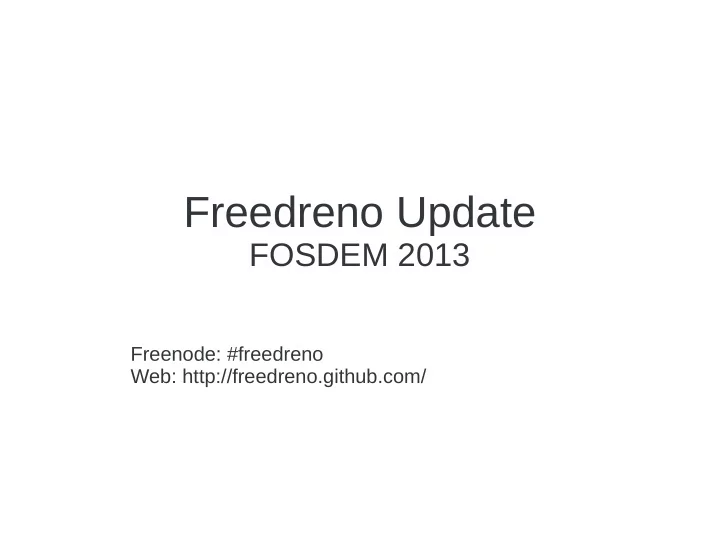

Freedreno Update FOSDEM 2013 Freenode: #freedreno Web: http://freedreno.github.com/
Motivation: Lack of opensrc gfx on ARM ● Open Source is about freedom – If you have the src and the will, you have a way ● New widget, new feature, new distro... ● For modern UI the GPU becomes more important – If you don't have the src, then you are limited by the blob ● Android is dominant because of the blob – Gives SoC vendors a single platform to support – Doesn't really care that platform drivers work in a clean/sane way or reusability outside of android – Either use android or unaccelerated ● As a result → hacks – Boot to Gecko using android HALs – libhybris – dynamic loader hacks to reuse blobs – But will just be all sorts of glue / duct tape ● But lima/mali gave some hope that things can change
History ● 2d – z180 – Started working on intercepting/parsing 2d cmds in march 2012 – Basic EXA (fill/solid/composite) working in Apr – After that, mostly sidetracked on 3d – Batching working in Oct – Still a bit in need of some love and debugging ● 3d – a220 – Intercepting and initial parsing 3d cmds in Apr – First renders with fdre end of Jun ● Using hard-coded, pre-compiled shaders – Start on shader disassembler in early Jul – Shader assembler for fdre and of Jul – Gallium driver started Nov
Adreno Overview ● 3d core – a2xx, a3xx – Origin: ATI/AMD Imageon ● Similar heritage as r300/r600 – Psuedo-TBDR ● Hidden surface removal ● Memory bandwidth reduction in common cases ● GMEM macro-tile: 256KiB or 512KiB vs 16x16 or 32x32 ● Starting with a330, OCMEM (on-chip mem) instead of GMEM.. seems to be shared w/ other accelerators like video codecs – I suspect similar to xbox360 / Xenos ● 2d core – z1xx – Origin: bitboys (I think) – OpenVG core... but focusing on what is needed for EXA – Not really any similarity to 3d core, different CP format, no GMEM, etc – Different adreno versions have zero, one, or two 2d cores
Tools of the Trade... libwrap.so – intercept ioctls, dump gpu buffers and cmdstream ● redump – cmdstream parser / diff-tool for 2d ● cffdump – cmdstream parser for 3d ● – Follows gpu ptrs (IB's, vertices, consts) – Shader disassembler – Some register bitfield and PM4 opc parsing pgmdump ● – Shader program binaries dumped via GL_OES_get_program_binary extension implemented in blob driver – Shader disassembler – Used in shader ISA r/e to compare output of similar shaders, to find instruction opcodes, etc fdre ● – Simple GL-like API – an easy way to exercise the GPU – Shader assembler – Depth/stencil/textures working – Used before gallium driver, and now to have simple way to experiment and test theories ●
Tools of the Trade...
3d: Tiling ● Color buffer + Depth + Z must fit in GMEM – Side by side – 16bit Z or 24bit Z + 8bit stencil (optional) ● Rendering done in passes – GMEM is 512KiB on a220, 256KiB on a200 – Without using hw binning/tiling: ● Set scissor, IB to buffer w/ draw cmds – With hw binning (I think, not implemented yet): ● Simple vertex shader pass to figure out which vertices in which bin (to avoid running VS many times)
3d: commandstream ● Command Parser – Same as r300/r600 – PM4 type0/3 ● Registers – Few similar registers (but different offset) – Mostly different ● Opcodes – different ● “amd-gpu” kernel driver \o/ – Recently found kernel driver from freescale kernel – Has pretty much all regs/bitfields as of a200 – Opcode names/id's but not format
3d: commandstream IB – indirect branch ... clear/draw cmds tile0 tile0 tile1 tileN GPU begins executing from here Rendering within each tile works like traditional IMR ● The per-tile commands: ● “restore” (optional) – mem2gmem() – transfer current contents from system memory to GMEM (tile – buffer, color + depth/scissor) Setup window-offset and screen scissor – IB to clear/draw cmds – “resolve” – gmem2mem() – transfer GMEM contents back to system memory – Notes: ● Not yet using “hw binning” - looks like that should reduce vertex processing load for vertices not – related to the current tile The order of cmdstream building is not the same as order that GPU executes, and restore/resolve – steps dirty some state used in clear/draw calls, so some care must be taken
3d: ISA Unified shader ISA ● Separation of CF and ALU/FETCH ● – 48bit CF instructions in pairs ● Control flow instructions reference offset of ALU instructions in 3*dword (96bit) – 96bit ALU instructions ● Co-dispatch of vec4+scalar
3d: ISA uniform sampler2D g_NormalMap; uniform float foo; varying vec2 vTexCoord0; void main() { vec3 vNormal = vec3(2.0, 2.0, 0.0) * texture2D(g_NormalMap, vTexCoord0).xyz; vNormal.z = foo * -dot(vNormal, vNormal); gl_FragColor = vec4(vNormal, 1.0); } EXEC ADDR(0x2) CNT(0x3) FETCH: SAMPLE R0.xyz_ = R0.xyx CONST(0) LOCATION(CENTER) (S)ALU: MULv R0.xyz_ = R0, C1.xxzw EXEC ALLOC ALU: DOT3v R1.x___ = R0, R0 ALLOC PARAM/PIXEL SIZE(0x0) EXEC_END NOP EXEC_END ADDR(0x5) CNT(0x2) FETCH ALU: MAXv export0.xy_w = R0, R0 MAXs export0.___w = R0 MULv ALU: MULv export0.__z_ = -R1.xyxw, C0.xyxw DOT3v NOP MAXv + MAXs MULv
Status ● Hardware: – So far, just a220/z180 – Snapdragon S3 (APQ8060, MSM8260, MSM8660) ● eg. HP touchpad, dragonboard – a200/z160 looks like it should be pretty similar, not sure about others – nexux-4 with a320 on order, so we shall soon see :-) ● EXA/2d support: – Basics work, some bugs – Composite blits w/ mask surface not implemented yet – Enough registers understood, so just need time to implement ● Gallium/3d support: – Basics work, some bugs ● >50% of glmark2, xbmc, compiz, q3a – Still needed ● cmdstream: MSAA, mipmap textures ● compiler: loops, optimizing ● hw binning
Recommend
More recommend